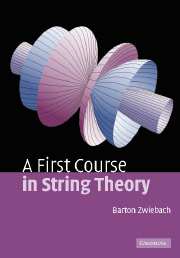Book contents
- Frontmatter
- Contents
- Foreword
- Preface
- Acknowledgements
- Part I Basics
- 1 A brief introduction
- 2 Special relativity and extra dimensions
- 3 Electromagnetism and gravitation in various dimensions
- 4 Nonrelativistic strings
- 5 The relativistic point particle
- 6 Relativistic strings
- 7 String parameterization and classical motion
- 8 World-sheet currents
- 9 Light-cone relativistic strings
- 10 Light-cone fields and particles
- 11 The relativistic quantum point particle
- 12 Relativistic quantum open strings
- 13 Relativistic quantum closed strings
- Part II Developments
- References
- Index
1 - A brief introduction
from Part I - Basics
- Frontmatter
- Contents
- Foreword
- Preface
- Acknowledgements
- Part I Basics
- 1 A brief introduction
- 2 Special relativity and extra dimensions
- 3 Electromagnetism and gravitation in various dimensions
- 4 Nonrelativistic strings
- 5 The relativistic point particle
- 6 Relativistic strings
- 7 String parameterization and classical motion
- 8 World-sheet currents
- 9 Light-cone relativistic strings
- 10 Light-cone fields and particles
- 11 The relativistic quantum point particle
- 12 Relativistic quantum open strings
- 13 Relativistic quantum closed strings
- Part II Developments
- References
- Index
Summary
Here we meet string theory for the first time. We see how it fits into the historical development of physics, and how it aims to provide a unified description of all fundamental interactions.
The road to unification
Over the course of time, the development of physics has been marked by unifications: events when different phenomena were recognized to be related and theories were adjusted to reflect such recognition. One of the most significant of these unifications occurred in the nineteenth century.
For a while, electricity and magnetism had appeared to be unrelated physical phenomena. Electricity was studied first. The remarkable experiments of Cavendish were performed in the period from 1771 to 1773. They were followed by the investigations of Coulomb, which were completed in 1785. These works provided a theory of static electricity, or electrostatics. Subsequent research into magnetism, however, began to reveal connections with electricity. In 1819 Oersted discovered that the electric current on a wire can deflect the needle of a compass placed nearby. Shortly thereafter, Biot-Savart (1820) and Ampère (1820–1825) established the rules by which electric currents produce magnetic fields. A crucial step was taken by Michael Faraday (1831), who showed that that changing magnetic fields generate electric fields. Equations that described all of these results became available, but they were, in fact, inconsistent. It was James Clerk Maxwell (1865) who constructed a consistent set of equations by adding a new term to one of the equations.
- Type
- Chapter
- Information
- A First Course in String Theory , pp. 3 - 11Publisher: Cambridge University PressPrint publication year: 2004



